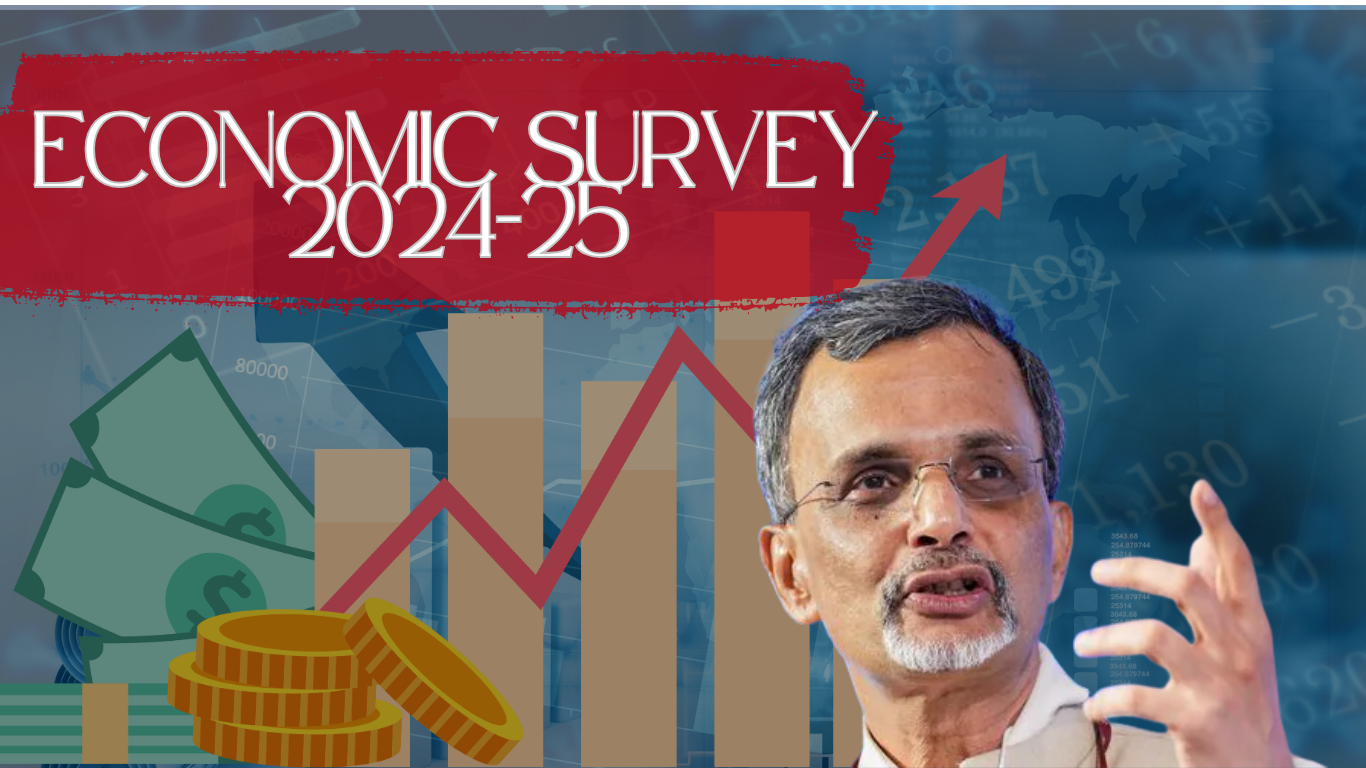The Economic Survey 2024-25, presented in Parliament by Finance Minister Nirmala Sitharaman on January 31, 2025, offers a detailed review of India’s economic performance over the past year and projections for the upcoming fiscal year. Prepared by the Department of Economic Affairs under the guidance of Chief Economic Advisor (CEA) V. Anantha Nageswaran, the Survey plays a crucial role in shaping policy decisions, highlighting challenges, and suggesting strategies for strengthening economic resilience.
This year’s Survey offers a balanced outlook, emphasizing India’s economic stability amidst global uncertainties, while also recognizing structural weaknesses that could limit long-term growth. It stresses the need for deregulation, business reforms, and a more enterprise-friendly environment to maintain India’s growth trajectory.
Global Economic Context:
The Economic Survey 2024-25 highlights two major global concerns that could impact India’s economic trajectory:
1. Slowdown in Global Trade and Investment
The global economic environment has become increasingly unfavorable. Global trade and investment have slowed significantly, a trend driven by the rise of protectionism and a decline in globalization. Geopolitical tensions and economic uncertainty have contributed to stagnation in global trade. The Survey warns of the emergence of secular stagnation—a prolonged period of low global economic growth.
2. China’s Dominance in Global Manufacturing
The Survey underscores China’s significant role in global manufacturing, accounting for one-third of total global production, which is more than the next 10 largest manufacturing economies combined. However, geopolitical shifts, economic fragmentation, and concerns over supply chains have led to a reevaluation of global manufacturing strategies. The world’s dependency on China for manufacturing—established during the era of globalization—is likely to reset, presenting both challenges and opportunities for India.
State of the Indian Economy:
1. Real GDP Growth: The Survey projects India’s Real GDP growth at 6.4% for FY 2024-25, with growth expected to range from 6.3% to 6.8% for FY 2025-26. This stable growth reflects strong domestic demand, improved private investment, and robust services sector performance.
2. Rising Private Consumption: Private Final Consumption Expenditure (PFCE), which measures spending by individuals on goods and services, is projected to rise. The share of PFCE in India’s GDP is expected to increase from 60.3% in FY24 to 61.8% in FY25. This would mark the highest level of private consumption since FY03, driven by strong consumer confidence, increased disposable income, expanding middle-class consumption, and urbanization.
3. Gross Value Added (GVA): Aggregate Gross Value Added (GVA) has surpassed pre-pandemic trends and remains above historical levels, indicating consistent growth across key sectors such as manufacturing, services, and agriculture.
4. Inflation Trends: The Survey notes that headline inflation has moderated, primarily due to a decline in core inflation (which excludes food and fuel prices). However, food inflation remains a concern, increasing from 7.5% in FY24 to 8.4% in FY25.
o Factors contributing to rising food inflation include supply chain disruptions, weather-related uncertainties impacting agricultural output, and rising prices of essential commodities like vegetables and pulses.
o The government aims to stabilize inflation through targeted interventions in food supply chains while maintaining monetary policy flexibility.
Sectoral Growth
- Agricultural Growth
The agricultural sector is expected to grow by 3.8% in FY25. The first half of FY25 saw steady agricultural growth, with Q2 recording an improvement to 3.5%. This growth is supported by healthy Kharif production, favorable monsoon conditions, and high reservoir levels that helped support irrigation and crop productivity. Total Kharif food grain production for FY25 is expected to reach a record 1647.05 lakh metric tonnes (LMT), marking a 5.7% increase compared to FY24. Agricultural resilience is essential for supporting the rural economy and ensuring food security. - Industrial Sector Performance
India’s industrial sector is projected to grow by 6.2% in FY25, driven by strong performance in construction activities, electricity, gas, water supply, and other utility services. However, industrial growth faced challenges in FY25’s first half, particularly in Q2, due to weaker manufacturing exports, disruptions caused by above-average monsoons, and mixed effects from festive seasons. Despite these challenges, India’s manufacturing Purchasing Managers' Index (PMI) remains one of the fastest-growing globally, signaling robust demand and production activity in the domestic market. - Services Sector Growth
The services sector continues to outperform other sectors, with a projected growth rate of 7.2% in FY25. In the first half of FY25, the sector grew by 7.1%. This growth is driven by financial services, real estate, professional services, public administration, and defense. India’s services exports surged by 12.8% between April and November FY25, reflecting the sector's competitiveness in the global market, particularly in IT and business services.
External Sector Performance
- Trade and Current Account
India’s merchandise exports grew by 1.6% YoY from April to December 2024. While merchandise imports rose by 5.2%, the strong performance in services exports helped offset the imbalance, maintaining India’s position as the seventh-largest exporter of services globally. Remittances from abroad have also played a significant role in keeping the current account deficit (CAD) relatively contained at 1.2% of GDP in Q2 FY25. - Foreign Direct Investment (FDI)
FDI inflows to India saw a notable revival, increasing by 17.9% YoY, from USD 47.2 billion in FY24 to USD 55.6 billion in FY25. This growth highlights India’s appeal as an investment destination, driven by economic reforms, political stability, and a large consumer market.
Infrastructure and Renewable Energy
- Infrastructure Development
Infrastructure investment remains a key priority for long-term growth. The government’s focus on expanding rail and port capacities is evident, with 2031 km of railway network commissioned and 17 new pairs of Vande Bharat trains introduced between April and November 2024, further enhancing connectivity. - Renewable Energy
India’s renewable energy capacity increased by 15.8% YoY by December 2024. The government’s emphasis on green investments, such as the National Green Hydrogen Mission and PM-KUSUM, is expected to accelerate the transition to a low-carbon economy.
Employment and Labour Market: Improving Trends
The Economic Survey reports positive employment trends, supported by post-pandemic recovery, increased formalization of jobs, and rising workforce participation. According to the 2023-24 Periodic Labour Force Survey (PLFS):
- The unemployment rate has declined.
- The Labour Force Participation Rate (LFPR) has improved, indicating increased job opportunities.
- The Worker-to-Population Ratio (WPR) has risen, reflecting greater workforce engagement.
However, structural challenges in job quality and wage growth persist.
Policy Recommendations:
1. Deregulation for Economic Growth
The Survey calls for simplifying business regulations, particularly for small and medium enterprises (SMEs). Reducing bureaucratic hurdles will lower the cost of doing business, encourage entrepreneurship, and stimulate investment and job creation.
2. Business Reform Action Plan (BRAP)
The Department for Promotion of Industry and Internal Trade (DPIIT) has introduced the Business Reform Action Plan (BRAP), aiming to foster business-friendly policies. The Survey stresses the importance of implementing BRAP in emerging and aspiring states to boost industrial growth.
3. Addressing Infrastructure and Investment Gaps
The Survey highlights India’s challenges in producing critical goods at scale and quality. Strengthening domestic manufacturing and infrastructure investments is crucial for long-term economic stability.
Conclusion:
The Economic Survey 2024-25 provides a detailed and nuanced assessment of India’s economic trajectory. While GDP growth remains steady, addressing structural challenges such as inflation, regulatory bottlenecks, and industrial capacity constraints will be crucial for maintaining momentum. The key policy priorities are:
1. Deregulation to encourage business expansion and job creation.
2. Enhancing industrial and infrastructure capacity.
3. Stabilizing inflation through supply-side interventions.
4. Strengthening the labour market for sustainable employment growth.
India’s ability to implement pro-business policies, attract investments, and improve industrial competitiveness will be central to sustaining its economic momentum.
| Main question: With respect to the global slowdown and trade tensions discussed in the Economic Survey 2024-25, analyze how India can mitigate the risks posed by these external factors and continue on its growth path. |








